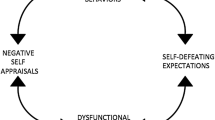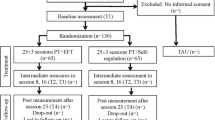Abstract
Psychodynamic psychotherapy (PDT) and emotion-focused therapy (EFT) have much in common and much to offer one another. Yet, their differing theoretical foundations create challenges when attempting to integrate the two. PDT is founded on concepts such as the dynamic unconscious, defenses, a developmental perspective and recurrent patterns including transference that are not included in EFT theory. By contrast, EFT is founded on basic affective science rather than clinical observations, a focus on experiencing affect fully rather than simply overcoming defenses and an emphasis on gestalt methods such as 2-chair work rather than working mainly within the experiential field of the therapeutic dyad. If one were to aim for a more balanced integration key psychodynamic concepts would need to be reconceptualized in more empirically-tractable terms and concepts. The central thesis of this paper is that psychodynamic concepts could have broader and more generalized application and potential for integration with other modalities if they were updated in light of advances in affective science and neuroscience. Specific core concepts addressed in this way include unconscious processes, development, conflicts, defenses and the mechanisms of therapeutic change. These conceptual refinements highlight the importance of observable behavior, emotional experiencing and learning in defining the nature of clinical problems and their treatment.
Similar content being viewed by others
References
Bargh, J. A., & Morsella, E. (2008). The unconscious mind. Perspectives on Psychological Science,3(1), 73–79.
Barlow, D. H., Farchione, T. J., Sauer-Zavala, S., Latin, H. M., Ellard, K. K., Bullis, J. R., et al. (2017). Unified protocol for transdiagnostic treatment of emotional disorders: Therapist guide. Oxford: Oxford University Press.
Barrett, L. F. (2017). How emotions are made: The secret life of the brain. New York: Houghton Mifflin Harcourt.
Beutel, M., Greenberg, L., Lane, R. D., Wiltink, J., & Subic-Wrana, C. (2019). Treating anxiety disorders by emotion-focused psychodynamic psychotherapy (EFPP): A transdiagnostic and integrative approach. Clinical Psychology and Psychotherapy,26(1), 1–13.
Blatt, S. J. (2008). Polarities of experience. Relatedness and self-definition in personality development, psychopathology, and the therapeutic process. Washington, DC: American Psychological Association.
Bornstein, R. F. (2001). The impending death of psychoanalysis. Psychoanalytic Psychology,18(1), 3–20.
Bowlby, J. (1973). Attachment and loss, vol. II: Separation. New York: Basic Books.
Brenner, C. (1974). An elementary textbook of psychoanalysis. New York: Anchor.
Cabaniss, D. L. (2016). Psychodynamic psychotherapy: A clinical manual. Hoboken: Wiley.
Dehaene, S. (2014). Consciousness and the brain. New York: Viking Press.
Elsey, J. W., Van Ast, V. A., & Kindt, M. (2018). Human memory reconsolidation: A guiding framework and critical review of the evidence. Psychological Bulletin,144(8), 797.
Erikson, E. H. (1993). Childhood and society. New York: WW Norton.
Freud, S. (1895/1950). Project for a scientific psychology (1950 [1895]). In The standard edition of the complete psychological works of Sigmund Freud (pp. 281–391), Volume I (1886–1899): Pre-psycho-analytic publications and unpublished drafts.
Freud, S. (1920/1955). Beyond the pleasure principle. In The standard edition of the complete psychological works of Sigmund Freud, Volume XVIII (1920–1922): Beyond the pleasure principle, Group psychology and other works.
Gabbard, G. O. (2017). Psychodynamic psychiatry in clinical practice (5th ed.). Washington, DC: American Psychiatric Association Publishing.
Gazzaniga, M. (1998). The mind’s past. California: University of California Press.
Gendlin, E. (1982). Focusing. New York: Bantam Books.
Greenberg, L. (2014). The therapeutic relationship in emotion-focused therapy. Psychotherapy,51(3), 350.
Greenberg, L. S., & Watson, J. C. (2006). Emotion-focused therapy for depression. American Psychological Association.
Greenberg, L. S. (2002). Emotion-focused therapy: Coaching clients to work through feelings. Washington, DC: American Psychological Association.
Greenberg, L.S., & Goldman, R. N. (in press). Handbook of emotion focused therapy. Washington, DC: American Psychological Association.
Kohut, H. (1971). The analysis of the self. New York: International Universities Press.
Lane, R., Carmichael, C., & Reis, H. (2011). Differentiation in the momentary rating of somatic symptoms covaries with trait emotional awareness in patients at risk for sudden cardiac death. Psychosomatic Medicine,73, 185–192.
Lane, R. D. (2000). Neural correlates of conscious emotional experience. In R. D. Lane & L. Nadel (Eds.), Cognitive neuroscience of emotion (pp. 345–370). Oxford: Oxford University Press.
Lane, R. D. (2020). Affective origin and treatment of recurrent maladaptive patterns. In R. D. Lane & L. Nadel (Eds.), Neuroscience of enduring change: Implications for psychotherapy (pp. 359–390). Oxford: Oxford University Press.
Lane, R. D., & Garfield, D. (2005). Becoming aware of feelings: Integration of cognitive-developmental, neuroscientific and psychoanalytic perspectives. Neuropsychoanalysis,7, 5–30.
Lane, R. D., & Pollerman, B. (2002). Complexity of emotion representations. In L. F. Barrett & P. Salovey (Eds.), The wisdom in feeling (pp. 271–293). New York: Guilford.
Lane, R. D., Quinlan, D., Schwartz, G., Walker, P., & Zeitlin, S. (1990). The levels of emotional awareness scale: A cognitive-developmental measure of emotion. Journal of Personality Assessment,55(1), 124–134.
Lane, R. D., Ryan, L., Nadel, L., & Greenberg, L. (2015a). Memory reconsolidation, emotional arousal and the process of change in psychotherapy: New insights from brain science. Behavioral and Brain Sciences,38, 1–19.
Lane, R. D., & Schwartz, G. (1987). Levels of emotional awareness: A cognitive-developmental and its application to psychopathology. American Journal of Psychiatry,144(2), 133–143.
Lane, R. D., Weihs, K. L., Herring, A., Hishaw, A., & Smith, R. (2015b). Affective agnosia: Expansion of the alexithymia construct and a new opportunity to integrate and extend Freud’s legacy. Neuroscience and Biobehavioral Reviews,55, 594–611.
Levenson, R. W. (1994). Human emotion: A functional view. In P. Ekman & R. J. Davidson (Eds.), The nature of emotion: Fundamental questions (pp. 123–126). Oxford: Oxford University Press.
Levinson, D. J. (1978). The seasons of a man’s life. New York: Random House Digital.
Mahler, M. S., Pine, F., & Bergman, A. (2000). The psychological birth of the human infant: Symbiosis and individuation. New York: Basic Books.
Malan, D. (1995). Individual psychotherapy and the science of psychodynamics. New York: CRC Press.
McAleavey, A. A., & Castonguay, L. G. (2015). The process of change in psychotherapy: Common and unique factors. In Psychotherapy research (pp. 293–310). New York: Springer.
McWilliams, N. (2011). Psychoanalytic diagnosis: Understanding personality structure in the clinical process. New York: Guilford Press.
Mitchell, S. A. (1988). Relational concepts in psychoanalysis: An integration. New York: Harvard University Press.
Panksepp, J., Lane, R., Solms, M., & Smith, R. (2017). Reconciling the cognitive and affective neuroscience perspectives on the brain basis of emotional experience. Neuroscience and Biobehavioral Reviews,76, 187–215.
Piaget, J. (1937). La construction du réel. Neuchâtel: Delachaux et Niestlé.
Safran, J. D. (2012). Psychoanalysis and psychoanalytic therapies. Wahington, DC: American Psychological Association.
Schwabe, L., Joëls, M., Roozendaal, B., Wolf, O. T., & Oitzl, M. S. (2012). Stress effects on memory: An update and integration. Neuroscience & Biobehavioral Reviews,36, 1740–1749.
Smith, R., & Lane, R. D. (2016). Unconscious emotion: A cognitive neuroscientific perspective. Neuroscience and Biobehavioral Reviews,69, 216–238.
Solms, M. (2013). The conscious id. Neuropsychoanalysis,15(1), 5–19.
Solms, M. (2015). Reconsolidation: Turning consciousness into memory. Behavioral and Brain Sciences,38, 40–41.
Stern, D. (1985). The interpersonal world of the infant. New York: Basic Books.
Stern, D. N. (2004). The present moment in psychotherapy and everyday life. New York: W. W. Norton.
Stern, D. B. (2013). Unformulated experience: From dissociation to imagination in psychoanalysis. New York: Routledge.
Versluis, A., Verkuil, B., Lane, R. D., Hagemann, D., Thayer, J. F., & Brosschot, J. F. (2018). Ecological momentary assessment of emotional awareness: Preliminary evaluation of psychometric properties. Current Psychology. https://doi.org/10.1007/s12144-018-0074-6.
Author information
Authors and Affiliations
Corresponding author
Additional information
Publisher's Note
Springer Nature remains neutral with regard to jurisdictional claims in published maps and institutional affiliations.
Rights and permissions
About this article
Cite this article
Lane, R.D. Promoting the Integration of Psychodynamic and Emotion-Focused Psychotherapies Through Advances in Affective Science and Neuroscience. Clin Soc Work J 48, 279–286 (2020). https://doi.org/10.1007/s10615-020-00759-8
Published:
Issue Date:
DOI: https://doi.org/10.1007/s10615-020-00759-8




